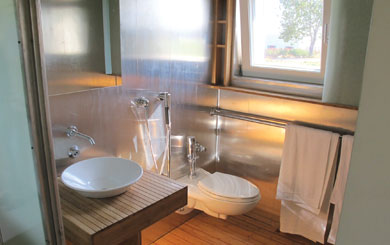Melanie wants her home to be comfortable and bright. Winter gusts send her to the thermostat to fight the chill, and in summer she nudges the temperature down to keep cool.
Meanwhile, Melanie’s husband Scott finds comfort in lower utility bills, so he frowns on tweaking the dial and walks through their home, turning off lights.
Fortunately, a comfortable middle ground is both affordable and available. Energy-saving products combined with efficient design trends and building techniques are revolutionizing home energy use.
Regardless of location or residence type, people like Melanie and Scott are finding that being energy efficient brings comfort as well as positively impacting their wallets and the world.
“If you’re concerned about the environment, being energy efficient is a priority,” says Brian Sloboda, a senior program manager for the National Rural Electric Cooperative Association (NRECA). “But efficient energy use is also important for other reasons. First, you save money. Second, you save energy, which leads back to saving money.”
It’s easy to ignore being wise with our energy consumption. After all, electricity is a good value. Unlike other energy sources, electricity is very flexible—we can use it for everything from cooking and cleaning to powering entertainment devices and even automobiles. Regardless, it makes sense (and cents) to be more energy efficient in all areas.
“Energy efficiency is a pocketbook issue,” adds Alan Shedd, residential/commercial energy director for NRECA’s Touchstone Energy Home program. “If you can do things to reduce energy costs, you’ll have more money to spend on other things.” Sure, we can’t control all energy costs (gasoline, for example), but we can make a difference in our own homes.
But how do we make that difference? Experts say future home construction and remodeling will focus even more on energy efficiency—especially proper sealing.
The best time to focus on energy savings, however, is at construction. “We’ve got to do a better job of sealing penetrations and gaps between the conditioned space—areas of the home that we heat and cool—and unconditioned spaces,” explains Art Thayer, energy efficiency programs director for the Michigan Electric Cooperative Association. “Find and seal gaps, cracks and penetrations near plumbing, cables, utilities, furnace runs, fireplace installations, and electrical wiring—anything that may allow air to move from one space to another.” When these gaps are sealed in a typical home, energy costs can drop between 20 and 40 percent.
Doing Detective Work
Home energy audits can help identify energy-loss areas, and audit professionals use special tools to identify potential improvements.
After a quick safety check on gas appliances, an energy audit expert will place a blower door on an exterior door. The device pressurizes the home, making air leaks easier to find. “The door simulates a 20-mile-per-hour wind coming at the house from all sides,” Thayer explains. “It creates a negative pressure so we can find out what the biggest problems are when it comes to comfort and energy. When we fix the comfort problem, we save energy, too.”
An energy auditor can also picture the home through an infrared camera to spot energy leaks, which most often occur in the attic. “Air escapes from places like the flue and chimney chase, plumbing stacks, electrical penetrations, and around kitchen and bathroom soffits,” Thayer says.
But trouble spots can’t be fixed just by rolling out more insulation. Specific spaces need to be sealed first. “Insulation is not air-sealing,” Thayer says, noting that many states require the blower test on new construction.
Electric co-ops are also willing to help their consumer-members learn about energy efficiency, and this varies by co-op from providing Energy Optimization programs (see story and ad in this issue offering free recycling and appliance rebates) to Country Lines articles and holding educational seminars. Other co-ops sell highly efficient water heaters and provide low-interest financing for energy efficiency improvements.
As an example, Midwest Energy Cooperative (Cassopolis) has an “Energy Express” demonstration trailer it uses at fairs, festivals, trade shows and other community events. “It’s an interactive educational tool that helps people understand some simple and inexpensive ways to increase home energy efficiency and maximize energy dollars,” says Patty Nowlin, communications director for Midwest.
“Finding efficiencies house-by-house or business-by-business, is a good thing,” Thayer adds.
Designed to Save
Older homes were built to a different standard, when energy was less expensive and efficiency less important, and some leak like sieves, Thayer continues. And, while these concerns are key for both remodeling and new home construction, it’s especially important in new homes where it’s a one-time decision about insulation, caulking and weather stripping. “With a little up-front investment you build-in lower overall operating costs,” he says.
Energy efficiency can also come from a home’s appliances, and many are manufactured with this emphasis, such as clothes washers, refrigerators and other aids bearing the Energy Star® logo.
Energy Star is branded by the Department of Energy and the Environmental Protection Agency. This means the appliance is a better value, and was proven in testing to provide significant energy savings over comparable products. Over 75 percent of the public understands the importance of looking for the Energy Star label, Thayer notes, and realizes that just a little more money means long-time savings.
Geothermal Offers More Savings
Perhaps nothing is as valuable, however, as savings realized after installing a geothermal heat pump as an alternative to more traditional heating and cooling units, Thayer advises. Using liquid-filled loops buried about 5 feet underground, this system uses the earth’s steady temperature to transfer heat.
Installation costs are high, but geothermal heat pumps deliver a 30 to 70 percent reduction in home heating and cooling costs. Plus, by using a desuperheater, they also deliver about 60 percent of a family’s hot water heating needs for free.
Because of their connection to the earth, geothermal heat pumps represent an interesting application of renewable energy, and currently receive a 30 percent tax credit. “That really brings the cost down to a level that’s par with high-efficiency systems,” he adds. “For new home construction, it’s a no-brainer. Why not do it?”
Heat pumps are also hard to beat because they can pay for themselves in just a few years.

With today’s stringent building codes, new homes are much more energy efficient than even just a few years ago, Thayer adds, and co-ops are increasing their educational efforts.
As another example, Midwest Energy is partnering with the Lenawee Intermediate School District’s Center for a Sustainable Future and other southeastern Michigan groups to build a state-of-the-art Sustainable Energy Efficient Demonstration House (SEED). The planned SEED house would serve as a unique educational tool for the whole community.
“We’re planning to build this house so that any of our co-op members, the community, and students can walk through and realize that energy conservation is practical, affordable and easy to understand in their own homes,” says Roger Bowser, Midwest’s energy programs and services manager.
Plans are for the house to be a “cut-away” design so it can show that if a house is newly-built, remodeled or energy-retrofitted as a “system,” it can be air-tight, comfortable and affordable, but still provide fresh, healthy, indoor air quality. “I want our members to understand if they are building, remodeling or energy-retrofitting their home, it should be very attainable and affordable for them,” Bowser explains.
Another co-op, Cherryland Electric, is offering its members that are interested in energy efficiency the opportunity to buy solar panels. The plan is to build a community solar panel array near the co-op’s office on U.S.-31 in Grawn. Now in the first phase, a total of 80 panels are being offered. Cherryland will retain ownership of the panels, then lease them to members for a one-time fee of $470 per panel. In return, members will receive an approximate $2 rebate per bill. Participating members can expect to break even on the investment in about 20 years, and that time frame could be shortened with energy optimization credits. The project’s size could eventually offer 360 panels or more over the long-term.
“It’s been very positive,” say General Manager Tony Anderson. “I think people want to support our renewable energy, and they are interested in making it work.”
Homes will soon be designed with future energy upgrades in mind, such as solar opportunities, Thayer adds. As we move to electric cars, we may begin seeing more solar panels on garages and carports, too.
Homes will also have “smart” appliances, energy efficiency controls, and a monitoring system. “Appliances will have a bigger impact because energy-efficient ones will be prevalent,” Thayer says, adding that the move to LED lighting will quicken and TVs and computers will become even more efficient.
“From the outside, you probably won’t see a lot of difference in the way homes look,” Thayer notes, “but what’s on the inside—from construction to appliances—will definitely be different.”
-Les O’Dell





